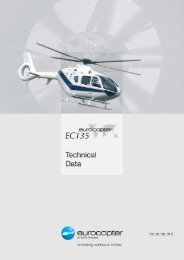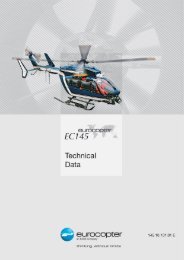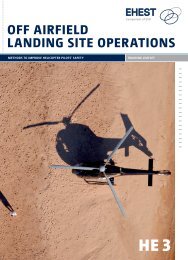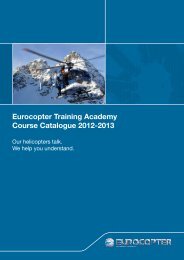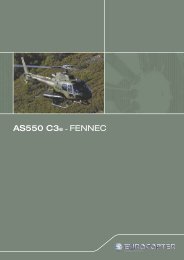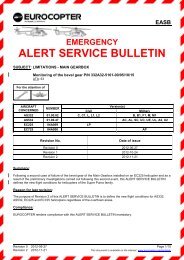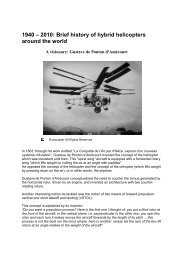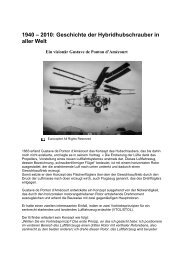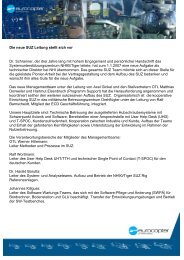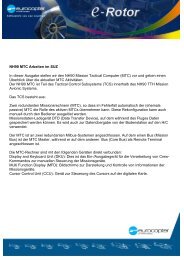LUXURY AND UTILITY COMBINED - Eurocopter
LUXURY AND UTILITY COMBINED - Eurocopter
LUXURY AND UTILITY COMBINED - Eurocopter
Create successful ePaper yourself
Turn your PDF publications into a flip-book with our unique Google optimized e-Paper software.
28 LIFE OF THE RANGE<br />
SUPER FRELON<br />
A VIRTUOSO TAKES ITS FINAL BOW<br />
On May 5, 2010, the last remaining helicopter in the French Navy’s Super Frelon fleet<br />
flew in to Marignane on a brief farewell visit to the place where it first took flight<br />
almost 50 years ago. The following day, it made its final journey to the helicopter<br />
museum in Dax. We pay tribute to this virtuoso of the skies.<br />
© Éric Raz / <strong>Eurocopter</strong><br />
Lieutenant Christophe<br />
Noyer, an experienced<br />
operational pilot<br />
(with 4,000 flight hours<br />
to his credit, including<br />
2,200 aboard the<br />
Super Frelon) and<br />
second-in-command<br />
of Flotilla 32F.<br />
What was it like to fly the<br />
Super Frelon?<br />
Christophe Noyer t It was an outstanding<br />
aircraft for its time, robustly built and capable of<br />
performing under the most demanding conditions,<br />
with an exceptional payload capacity that<br />
resulted in its being deployed on every type of<br />
mission carried out by the French Navy. It was<br />
used to transport commando troops, perform<br />
Throughout its many years in service<br />
with the French Navy, the Super Frelon<br />
consistently demonstrated its capacity<br />
to provide almost 100% availability and<br />
a seldom-equaled level of performance.<br />
ROTOR JOURNAL - NO.87 - OCTOBER/NOVEMBER 2010<br />
INTERVIEWED BY: CHRISTIAN DA SILVA<br />
maritime search and rescue missions and as<br />
a supply helicopter for naval vessels at sea. In<br />
short, it was the workhorse of the French Naval<br />
Aviation. And like every other aircraft of its generation,<br />
it required a certain amount of physical<br />
effort to fly. You could always feel the vibrations<br />
and smell the hydraulic oil!<br />
What is the most difficult<br />
aspect of rescue operations?<br />
C.N. t We were on permanent standby,<br />
24 hours a day, 365 days a year, with only<br />
four crews and the same number of Super<br />
Frelons. The missions we flew when tankers<br />
like the Amoco Cadiz or the Ievoli Sun went<br />
down received a great deal of media attention.<br />
But in fact our most dangerous missions<br />
often involve rescuing the crews of sixty-foot<br />
© Alexandre Dubath<br />
yachts and small fishing vessels, in heavy seas<br />
and high winds in the dark of night. There are<br />
not many of us in this profession, and we have<br />
to work under enormous pressure. We train<br />
hard to perfect our know-how and our ability<br />
to handle the aircraft under all circumstances.<br />
In the heat of the action, when every second<br />
counts, the coordination of the helicopter crew<br />
is essential. The pilot and the winch operator<br />
have to remain in full control of the operating<br />
environment. We keep up our motivation by<br />
thinking about the people who need to be<br />
evacuated: If we don’t succeed, it will be a<br />
long time before anyone else can come to their<br />
rescue. We demand a lot of ourselves, but also<br />
of our aircraft, because the success of our missions<br />
ultimately depends on our confidence in<br />
its performance.<br />
What do you think about the<br />
arrival of the NH90 in your unit?<br />
C.N. t I am sure that the NH90 will improve<br />
our mission capabilities. Its performance,<br />
advanced modes and modern features will<br />
facilitate the transition, and it will reduce the<br />
pilot’s workload by automating certain control<br />
functions. We nevertheless have a lot of work<br />
to do because the new aircraft represents a<br />
huge technological leap forward. We will have<br />
to revise our mission strategy to take account<br />
of the new capabilities offered by the NH90 and<br />
get used to new procedures and equipment.<br />
In the end, we hope to be able to permanently<br />
widen the scope of our activities.<br />
During the transition period, we will be using<br />
the EC225/725 to maintain maritime rescue<br />
services. The modern technology integrated<br />
in these aircraft will help us to prepare for the<br />
introduction of the NH90 in the navy’s helicopter<br />
fleet. ■



